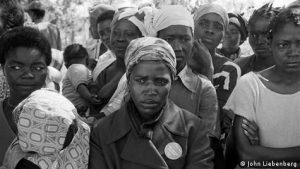10 December is worldwide commemorated as Human Rights Day. It marks the anniversary of the UN Universal Declaration of Human Rights adopted on that day in 1948. Many countries and organisations acknowledge this as a significant marker.
It created a lasting, normative framework defining fundamental human rights. UN Member States, while in constant violation, have all ratified the principles. They remain a moral and ethical compass demanding recognition and respect.
In Namibia, the day is marked as both International Human Rights Day as well as Namibian Women’s Day. The reason for this is that it marks an event that stands out in Namibian history as a reminder of human rights abuses in the past, as well as the significant role played by women in the struggle for the restoration of these rights.
An indiscriminate shooting by police took place on this date in 1959. Thirteen unarmed demonstrators were killed, among them one woman. More than 40 were wounded as they resisted their forced removal from an area known as the Old Location.
The events became a reference point for the national liberation movement, the South West African Peoples Organisation, which was formed in 1960 in response to the event. The actions of the demonstrators acted as a midwife to the organised anti-colonial liberation struggle that went on to gain new momentum, culminating in independence in 1990.
As diagnosed by the late South African historian Tony Emmett in his pioneering work on the formation of national resistance in Namibia:
The authorities’ attempts to move residents of the old location to a new township and the resistance they met represent a significant point in the political history of Namibia. … it transcended parochial issues and united a broad cross-section of groups and classes in a confrontation with the colonial state.
The Old Location
My research has included life in the Old Location, its history and the forced removal.
Since the early 20th century, the Location was the biggest Black urban settlement in Namibia. A former German colony since 1884, the territory then called South West Africa was in 1918 transferred as a League of Nation mandate to South Africa. Administered like a fifth province, apartheid policies institutionalised as “separate development” since the late 1940s, was also transferred to the adjacent country.
The Location was in walking distance to Windhoek’s town centre. Only a riverbed separated it from the suburb set aside for white people. Residents in the Location paid a fee for the area they occupied even though the constructions built for accommodation were their private ownership.
In line with apartheid policy, a decision was taken to move the people from the Location. Residents there were from a variety of indigenous communities in the country. Despite different cultural and linguistic backgrounds, they lived in peaceful cohabitation.
To remove them from the direct vicinity to the “White” city, a new township Katutura was created. It was separated by a buffer zone several kilometres apart from the city. It also divided the residents through ethnically (“tribally”) classified, strictly policed separate living quarters.
The houses there remained property of the administration, for which higher rents had to be paid. People of mixed descent, classified as so-called “Coloureds” were until then living in the Location. They were now forced to relocate to another separate suburb Khomasdal.
Hardly anyone living in the Main Location volunteered to move. Instead, as of late 1959, women initiated a boycott of services.
Following weeks of campaigns, a meeting with White officials took place in the Location on 10 December. Stones were thrown, and the police opened fire. The sheer brute force executed to break resistance marked the end of the Location.
As from 1960, people were moved to Katutura and Khomasdal. Their homes in the Location were bulldozed to the ground. It was officially closed in 1968, with no traces of its existence left.
Extensions to Katutura since then turned it into the biggest settlement in Namibia. The area of the former Location has been turned into middle class suburbia.
Remembering
Anna “Kakurukaze” Mungunda became the most widely acknowledged face of the resistance.
Narratives differ as regards her role. She was not a prominent resident before and had no involvement in the organised resistance. But police killed her when she was supposedly setting the car of one of the White officials on fire.
As the only woman killed, Mungunda is paid recognition and respect by a tombstone erected at the Windhoek Heroes Acre, inaugurated in 2002.
There is also an ongoing fight in Germany to get a street in Berlin named after her. The idea is to rename some of the colonial street names in the “African Quarter” (Afrikanisches Viertel). In particular, efforts are under way to change the Petersallee into Anna-Mungunda-Allee. Peters was a notorious colonial perpetrator in imperial Germany.
Implementation is on hold due to a legal intervention by some of the residents.
In Windhoek, parts of the neglected and dilapidated Location cemetery have been restored and upgraded to a memorial site and turned into an Old Location Cemetery Museum. It is a venue for commemoration and on the list of local tourist attractions.
Zedekia Ngavirue was employed as social worker in the Location in 1959/60. Politically active in the South West Africa National Union he founded and co-edited the first African newspaper “South West News”. Its nine issues have been reproduced in a compilation and are a treasure trove documenting discussion of the time.
In his introduction to the collection, “Dr Zed” (as he was later fondly called) might have captured the spirit of these days best:
It was, indeed, when we owned little that we were prepared to make the greatest sacrifices.



